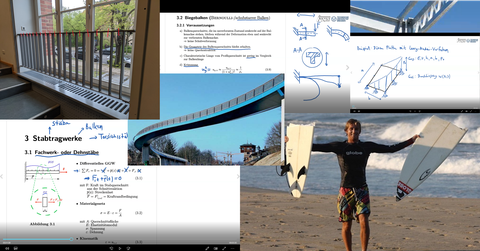Linear and planar load-bearing structural elements: Dr.-Ing. Adrian Ehrenhofer (#AE1)
Brief Description
The subject “Linear and planar load-bearing structural elements” is taught in the advanced courses of study Simulated Methods and Lightweight Construction within Mechanical Engineering. It is a specialization of the fundamental topic Technical Mechanics (TM). The subject expands on TM with additional physical effects that play an important role in constructions, such as warping torsion or the issue of flexibility in beams/panels.
Keywords
- Integration of lecture videos
- Hybrid teaching
- Methods of structural mechanics

Linear and planar load-bearing structural elements: Dr.-Ing. Adrian Ehrenhofer (#AE1)
What makes this gem special?
This semester, the lecture was designed to build on lecture videos as a hybrid course. In preparing each on-site lecture, 2–3 lecture videos of 20 minutes each were uploaded to OPAL, demonstrating the content of the lecture (derivations, presentations with specific applications, scripts, explanations of calculations). The on-site lectures were structured as follows:
- After a 5–10 minute overview of the topics to be covered, the students could first pose their own questions about the content of the lecture video. These were then discussed as a group.
- Subsequently, they would receive a list of around 6–10 questions to answer about the lecture topics. Following the think-pair-share method, the students first had about 2 minutes to think independently about an answer to the question, just as would be relevant later during the exam. Then, they were invited to pair up with a neighbor to discuss possibilities and rule out far-fetched ideas. At the end, the suggested answers were shared and discussed as an entire class and a “correct answer” was found.
- In the final portion of each lecture, short tasks were provided where the students could apply the newly learned principles and methods to their group topics. These were topics related to the interests of each group’s members (about 3–4 students per group), who had found each other between the first and second lectures. These included hobbies in the realms of sports and technology. The short tasks could then be submitted for feedback (assessment & discussion) at the end of each lecture.
At the end of the lecture series, the students had the opportunity to briefly present the findings about their group’s topics to their peers.
Related links
Contact
Organizational unit
Faculty of Mechanical Science and Engineering, Institute of Solid Mechanics (Chair of Mechanics of Multifunctional Structures) & Dresden Center for Intelligent Materials
Course size
31 to 100 students
Voting ID
#AE1